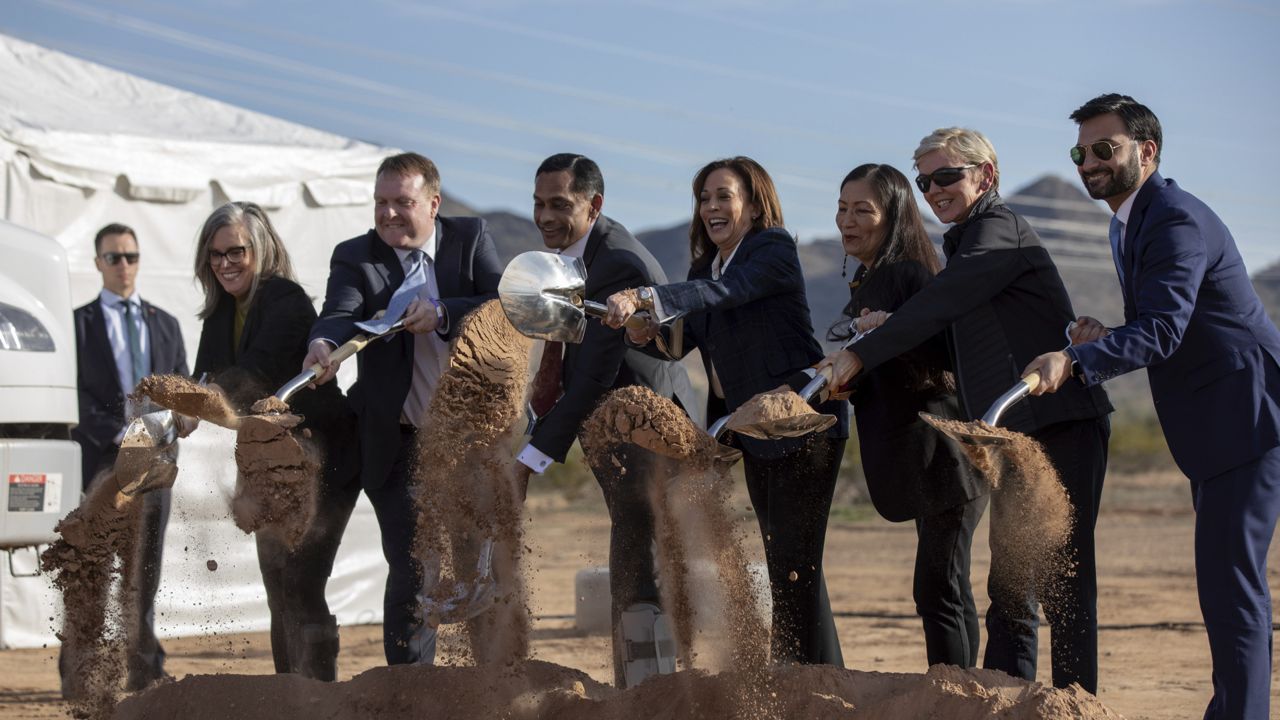Vice President Kamala Harris traveled to Tonopah, Arizona on Thursday for a groundbreaking event at the Ten West Link transmission line, a project that aims to increase energy accessibility and reliability through California and Arizona.
Harris was joined by a slew of administration and local officials for the ceremony, including Interior Secretary Haaland, Energy Secretary Granholm, White House National Climate Advisor Ali Zaidi and Gov. Katie Hobbs.
The line “will deliver electricity from wind and solar farms out here in the desert to big cities, like Phoenix and Los Angeles and San Diego, and to rural communities, like Blythe and Quartzsite,” Harris said after receiving a briefing on the project alongside workers from the International Brotherhood of Electrical Workers labor union.
IBEW workers are helping construct the 125-mile long transmission line, which connects electrical substations in Tonopah and Blythe, California. The line, expected to be operational by the end of the year, will have the tri-pronged benefits of enhancing regional collaboration in reaching energy goals, strengthening local energy reliability and conserving resources, per the project website.
“This electricity will be clean electricity. Solar panels and wind turbines do not produce toxic fumes that poison our air or dangerous chemicals that poison our water,” the vice president noted. “And the energy delivered by these lines will not just be cleaner. It will also be cheaper.”
Harris noted the transmission line will also protect communities at risk of severe weather events like floods and drought by strengthening the grid against potential overloads or outages.
The stop is one of many highlighting the administration’s work in moving towards President Joe Biden’s goal of a carbon pollution-free power grid by 2035, with a further aim of a net-zero emissions economy by 2050.
Arizona Gov. Hobbs on Thursday said her state “should lead the way in sustainable and renewable energy development,” thanking the federal government for its “focus and leadership” in greenlighting the Ten West Link transmission line.
“This transmission line will bring economic benefits including new jobs, resulting in indirect economic benefits such as secondary spending by those employed by the project and property tax revenues,” Hobbs said. “It's a boost to local communities and will contribute to a more sustainable and resilient Arizona.”
Harris added that the project “shows that when we invest in climate, we also invest in families, in communities, in opportunity and prosperity for all people.”
“When we invest in climate, we build a safer, cleaner, healthier, more just and more prosperous country,” the vice president concluded. “When we invest in climate, we invest in America.
After her stop in Arizona, Harris embarked for her home state of California, where after weeks of rain and flooding, she focused on drought and flood resistance.
The vice president visited Tujunga Spreading Grounds in Los Angeles County, where Sen. Alex Padilla, D-Calif., Rep. Tony Cárdenas, D-Calif., and other local officials joined her.
"I am here today to first and foremost thank the folks who, on the ground every day, have been doing the important and good work of responding to this extreme climate crisis that we have been experiencing around the world and certainly here in our home state of California," the vice president noted.
Tujunga Spreading Ground, which provides water to Los Angeles County, and the facility is currently undergoing an improvement project to increase capacity and percolation rate, which will improve the area’s ability to store rainwater underground.
Harris has been a champion of drought issues and resilience since she was a senator for the Golden State, and the White House is touting the administration’s ability to secure more than $12 billion for water infrastructure projects in the western part of the country though the Bipartisan Infrastructure Law.
"This plant, and this facility in particular, is doing some of the smartest and the most contemporary kind of work that is necessary to store water, understanding that the climate crisis presents here in California," Harris said Friday.
"Sometimes there will be days of immense water, of rain, of storms, flooding, and at the same time we are a state that has experienced, for generations, drought," the vice president continued. "And we must therefore understand that the issues that are present in the climate crisis are varied and it requires us to be present and to be in front of each of the iterations and variations that include extreme weather that produces a lot of water and extreme weather that produces drought."
President Joe Biden on Thursday also visited the Golden State to tour damage from recent floods, and delivered remarks on supporting the state's recovery at Seacliff State Park.
"While the situation is still treacherous, we're cautiously optimistic that the worst part is behind," Biden said, noting that the "federal government is not leaving its responsibility until it's all fixed, it's done."
More than 500 FEMA and other federal personnel have been deployed to California to support the emergency response operations.
“It was really important to the president, very important to the administrator that we hear directly from people who had been navigating just a really tough time with these most recent floods,” Marcus Coleman, a FEMA senior official, told Spectrum News of Thursday’s visit.
"I know that the president, if he could, he would hit every county and listen to every person," Coleman added. "But the thing that he's directed the FEMA administrator to do, and that she's committed to, is ensuring that we take the full footprint and force of not just FEMA but the federal family to make sure that we are making necessary adjustments to meet survivors where they are throughout the state."



